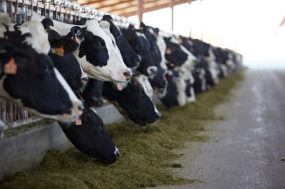A water footprint is the amount of water – including blue water (pumped water), green water (evaporated water) or grey water (pollution) – consumed. It can be measured per person or per unit of milk produced.

A water footprint is a new concept that can allow for better water sustainability practices. Guidelines from the International Dairy Federation focus on two key considerations for water sustainability on a dairy farm: water consumption (drinking, cleaning, irrigation) and water degradation (nutrient pollution).
There are different research approaches to investigate water use on the farm, and most revolve around studying water consumption and degradation.
Andrew VanderZaag and collaborators at Agriculture and Agri-food Canada, the University of Guelph, OMAFRA, LRIC and Wilfrid Laurier University looked at water use on 19 different farms in Ontario in a project financed under the Dairy Research Cluster 2 (2013-2018) to determine where potential water-saving changes could be implemented.
Over several years, barn water use was monitored, and studies were done on how milkhouse washwater was treated, as well as leaching from fields that occurred.
The in-barn studies found it takes from 4 to 7 litres of water to produce 1 litre of milk, an accumulation resulting from drinking water, general cleaning, parlour cleaning and waste. Based on these results, potential water-saving changes were identified.
Changes in the barn include recover all plate-cooler water, optimize cleaning protocols, especially with robotic systems, and ensure optimal cooling strategies are implemented in the summer months for cow comfort, which will decrease the need for increased water consumption to stay cool.
If all dairy operations in Canada were able to reduce in-barn water consumption by 1 percent, about 500 million litres of water would be saved annually.
Moreover, savings in pumped water (blue water) have potential for increased sustainability in that they often lead to energy savings as well (i.e., energy consumed by pumps, softeners, heaters, less water in manure to store and haul to fields, etc.). Additionally, reducing nutrient losses due to leaching, runoff and washwater reduces the water footprint.
The water footprint is a new concept, and consumer awareness is growing. Making small changes can reduce the amount of water consumed on a dairy farm and can reduce the amount of water required to produce milk. ![]()
See the full presentation made by VanderZaag at the 2018 Dairy Research Symposium on the Canadian Dairy Research Portal.
Caroline Corbett is a Ph.D. Candidate with the University of Calgary
Dairy Farmers of Canada (DFC) is the national policy, lobbying and promotional organization representing Canada’s farmers. DFC works to support sustainable dairy production; facilitate solutions to provincial/national challenges; provide credible research of dairy products on a national basis; and create innovative ways to grow the market.








